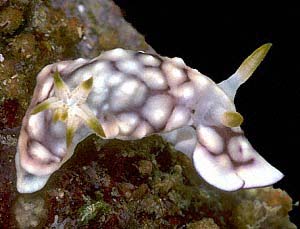

Chromodoris geometrica
Risbec, 1928
Order: NUDIBRANCHIA
Suborder: DORIDINA
Family: Chromodorididae
DISTRIBUTION
Tropical Indo-West Pacific.
PHOTO
UPPER: Coffs Harbour Region, northern New South Wales, December 1990. PHOTO: Bill Rudman.
LOWER: Siquijor Is., Philippines, Nov. 1998. Note purple on underside of anterior mantle. Photo: Erwin Koehler.
RELATED TOPIC
Mimics of Phyllidiella pustulosa.
Originally described from New Caledonia, there are now records from much of the Western Pacific. A very similarly coloured animal is found in the western Indian Ocean and was named Chromodoris conchyliata Yonow, 1984. Most authors have considered it a colour form of C. geometrica. Yonow (1994) has reported a dark, fairly "typical" colour form of C.geometrica from the Maldives in the Indian Ocean. This colour form is also reported here from the Philippines. See Valda Fraser's record from South Africa.
Apart from the characteristic dorsal colour pattern, which resembles a phyllidiid, this species is one of a group with a fairly large anterior mantle skirt which waves up and down as the animal crawls along, and is purple on its underside.
References:
• Rudman, W.B. (1977) Chromodorid opisthobranch Mollusca from East Africa and the tropical West Pacific. Zoological Journal of the Linnean Society, 61: 351-397.
• Yonow, N. (1993) Opisthobranchs from the Maldive Islands, including the descriptions of seven new species (Mollusca: Gastropoda). Revue francaise d'Aquariologie, 20(4): 97-130.
Rudman, W.B., 1999 (January 15) Chromodoris geometrica Risbec, 1928. [In] Sea Slug Forum. Australian Museum, Sydney. Available from http://www.seaslugforum.net/find/chrogeom
Related messages
Chromodoris geometrica
November 17, 2009
From: Koldo Urgoitia
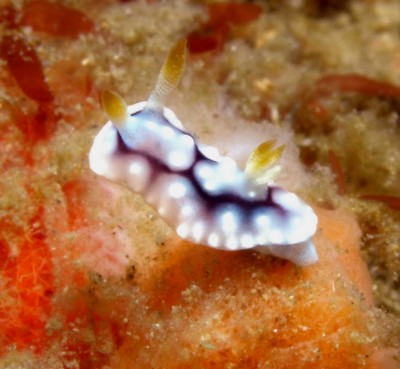
Hello, I can't find the name of this sea slug, can you help me? Thanks
Locality: Strait Lembeh, 18 meters, Indonesia, Celebes sea, 20 August 2009, gravel. Length: 15 mm ?????. Photographer: Koldo Urgoitia.
Koldo Urgoitia
urpekari@euskalnet.net
Urgoitia, J.K., 2009 (Nov 17) Chromodoris geometrica. [Message in] Sea Slug Forum. Australian Museum, Sydney. Available from http://www.seaslugforum.net/find/22790Dear Koldo,
This is Chromodoris geometrica
Best wishes,
Bill Rudman
Chromodoris cf. geometrica from Reunion Island
June 9, 2009
From: Philibert Bidgrain
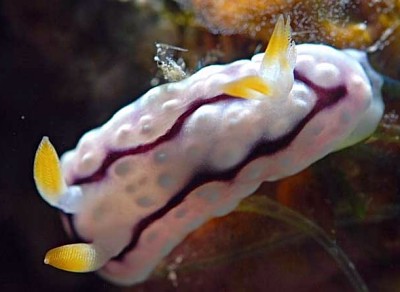
Concerning message #14131:
Dear Bill,
I have some hesitation about this seaslug ... It has some similarity with Colin Odgen's specimen of Chromodoris conchyliata, but many difference from classical specimens of this species observed in our island (see Philibert Bidgrain and Hugues Flodrops messages)
Locality: Saint Gilles, 20 m, Reunion Island, Indian Ocean, 5 October 2008. Photographer: Alain Diringer.
What's your opinion about this strange color form
Regards
Philibert Bidgrain
http://seaslugs.free.fr/index.htm
pbidgrain@yahoo.fr
Bidgrain, P., 2009 (Jun 9) Chromodoris cf. geometrica from Reunion Island. [Message in] Sea Slug Forum. Australian Museum, Sydney. Available from http://www.seaslugforum.net/find/22419Dear Philibert,
You have referred to one of a couple of messages we have from South Africa which show that both C. geometrica and C. conchyliata occur in the western Indian Ocean. I thnk we have seen enough specimens of these two species to see that it's not just the colour of the gills and rhinophores - reddish orange in C. conchyliata and yellow-green in C. geometrica - but that in C. conchyliata the edge of the gills is coloured, while in C. geometrica it is the upper half of all the gill which is coloured. So it's not just a change of colour but a change in the position of the colour.
You don't give me indication of the size of your animal, but I suspect it is a juvenile. One other difference is that in C. geometrica the underside of the front of the mantle is purple, while in C. conchyliata there is usually a broad orange outer band as well.
On those grounds, this is definitely C. geometrica.
Best wishes,
Bill Rudman
Chromodoris conchyliata in S.E. Qld
November 3, 2008
From: David Mullins
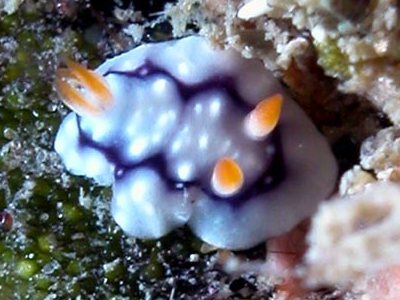
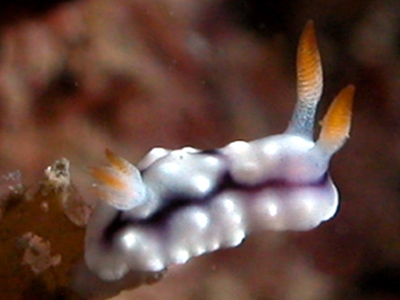
Concerning message #2570:
Dear Bill,
I read with great interest Valda Fraser's message [#2570 ] from S. Africa and your reply thereto which is at the moment quite a topical discussion for us as it would appear the reverse situation exists here in S.E. Qld.
Whereas we find Chromodoris geometrica (lower photo) not uncommonly on our dives it was only last weekend that we encounted a specimen in possession of orange gills and rhinophores with an orange clavus which has led us to believe it may well be Chromodoris conchyliata (upper photo ).
Upper Photo: Old Woman Island (Mudjimba Island) Maroochydore, Sunshine Coast,, 12 metres, Queensland, Australia., Pacific Ocean, 25 October 2008, Rocky Reef. Length: 6 mm. Photographer: David Mullins.
In reviewing my file of Chromodoris geometrica photos it would appear that we perhaps also unwittingly recorded it once before back in 2006 (middle photo ).
I should report, as it may be of significance, that on both occasions the "orange" specimens were quite small being no larger than 6 mm in length. I could not detect any colouration other than white on the mantle pustules.
(All these photos although taken at different times were at the same site within 100 metres.)
Yet more grist for the mill Bill?
Kind regards,
David Mullins.
marineimages@hotmail.com
Mullins, D.A., 2008 (Nov 3) Chromodoris conchyliata in S.E. Qld. [Message in] Sea Slug Forum. Australian Museum, Sydney. Available from http://www.seaslugforum.net/find/22003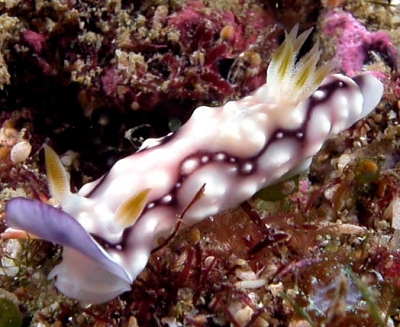
Thanks David,
If my profession was just matching colour photos with other colour photos I doubt if I could be bothered. It's the puzzles like this which make it interesting. I first came across the 'C. conchyliolata colour form" when I was in East Africa and labelled it Chromodoris cf. geometrica as I considered it most probably to be a colour form of that species (Rudman, 1973). Nathalie Yonow some years later considered to be a distinct species, C. conchyliolata, but the only real differences were its orange-red gills and rhinophores and the tendency for the opaque white pustules on the mantle to be yellowish. I can't say I have been that convinced with it being distinct, but as the gill and rhinophore colour is quite a good character in species of Chromodoris, I have remained fairly neutral.
As you mention, photos on the Forum suggest that in the western Indian Ocean the 'C. conchyliolata colour form" is most common, although some of the 'C. geometrica colour form' have been reported [messages #15244; #2570], while in the western Pacific the opposite occurs [message #11597 ].
Interestingly, in some, but not all C. conchyliolata, there is also a borad ornage band on the underside of the anterior mantle, as well as the purple. If my growing feeling that there is only one species is correct, perhaps the orange is a dominant colour pigment which only presents itself in certain conditions, much like the way black lines in other chromodorids can sometimes be partly orange. The egg ribbon of both looks identical, and they both seem to feed on the sponge Chelonaplysilla violacea. I guess we just have to continue building up information. I certainly have seen juveniles with green rhinophores, and some of the large animals have orange-red ones so I don't thinnk there can be a direct relationship between size and rhinophore. Perhaps someone will find the two colour forms mating - which won't convince everyone it seems - but would be quite a powerful indication.
-
Rudman, W.B. (1973a) Chromodorid opisthobranch Mollusca from the Indo-West Pacific. Zoological Journal of the Linnean Society 52(3): 175-199.
-
Yonow, N. (1984). Doridacean nudibranchs from Sri Lanka, with descriptions of four new species. The Veliger, 26(4): 214-228.
Best wishes,
Bill Rudman
Chromodoris geometrica - copepod parasites
June 11, 2008
From: Teresa Zuberbühler
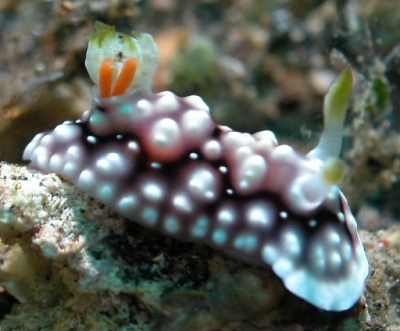
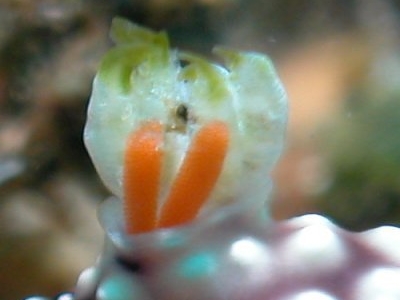
Concerning message #21340:
Dear Bill
The enclosed picture shows copepods in the gills of Chromodoris geometrica. This seems to be their favorite place to attach, since I have seen it several times, specially on Chromodoris geometrica.
Locality: Lembeh, 15-20m, Sulawesi, Indonesia, Pacific, July 05, sand and rubble. Length: 4-5cm. Photographer: Teresa (Zubi) Zuberbühler.
Greetings from Switzerland
Zubi
webmaster@starfish.ch
Zuberbühler, T., 2008 (Jun 11) Chromodoris geometrica - copepod parasites. [Message in] Sea Slug Forum. Australian Museum, Sydney. Available from http://www.seaslugforum.net/find/21605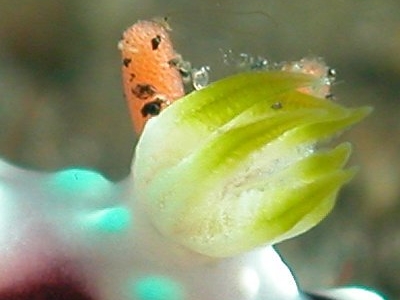
Dear Teresa or Zubi,
As you can see in the top photo on the symbiosis page, commensal and parasitic copepods associated with nudibranchs have a pair of large egg sacs attached to their rear end. The orange sacs in your photo are these egg sacs. In the case of C. geometrica - and many other nudibranchs - the copepods, don't just crawl around on the outside of the animal as in the symbiosis photo, but bury deep into the animal and feed off it. In dorids they are often found in the gill pocket like this.
Best wishes,
Bill Rudman
Re: Chromodoris geometrica waving anterior mantle
February 5, 2008
From: Leanne & David Atkinson
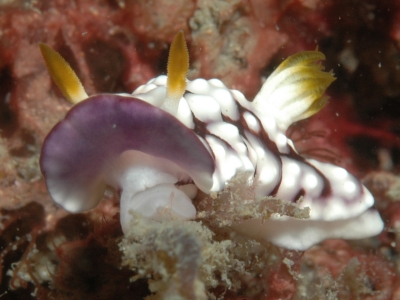
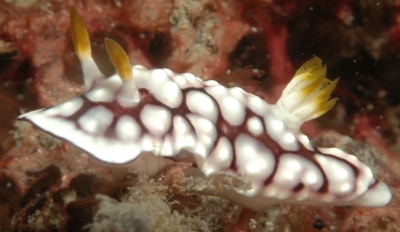
Concerning message #474:
Dear Bill,
We found this Chromodoris geometrica flapping its mantle. This series of photos show the lifting of the mantle and the purple underneath it also seems to have its mouth extended but did not seem to be eating. We thought you might like another example of it showing the nudibranch from a different angle.
Locality: The Pipeline, Nelson Bay, Port Stephens, 5 metres, New South Wales, Australia, Pacific, 7 January 2008, Sandy silty bottom seagrass, kelp, ascidians and scattered sponges. Length: approximately 25 mm. Photographer: Leanne & David Atkinson.
Best wishes,
Leanne & David Atkinson
atk@hunterlink.net.au
Atkinson, L. & D., 2008 (Feb 5) Re: Chromodoris geometrica waving anterior mantle. [Message in] Sea Slug Forum. Australian Museum, Sydney. Available from http://www.seaslugforum.net/find/21340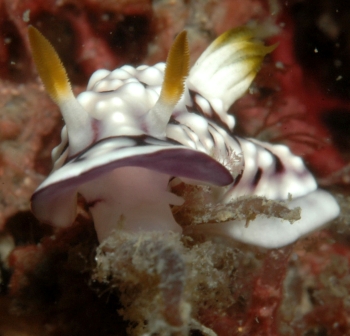
Dear Leanne & David,
Thanks for these photos. It certainly looks as though it has its oral tube extended. Perhaps the sponge colony is very small or perhaps it has just about finished eating it. Chromodoris geometrica is one of the species of Chromodoris which flaps only the front of its mantle which is purple on the underside.
Best wishes,
Bill Rudman
Chromodoris geometrica feeding
September 4, 2007
From: Denis Riek
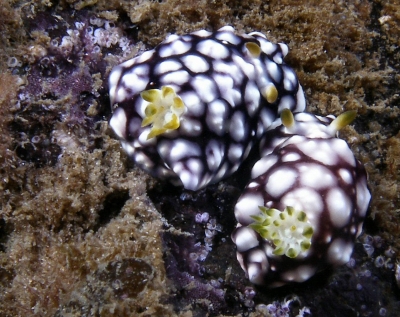
Dear Bill,
Here are some images of Chromodoris geometrica feeding on a dark purple sponge. Until the recent heavy rains there were many types of sponge in the Brunswick River but it appears that the very hard to see encrusting species are where I always found Chromodorids feeding. Unfortunately these sponges are so overgrown that it is very difficult to get a shot that actually shows something. These images don't show a lot but they may be of some help.
Locality: Brunswick River, 4 metres, Northern New South Wales, Australia, Pacific, 23 June 2007, Rock wall in river, high tide. Length: 40mm. Photographer: Denis Riek.
Cheers
Denis
dwriek@optusnet.com.au
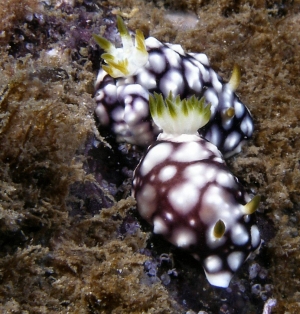
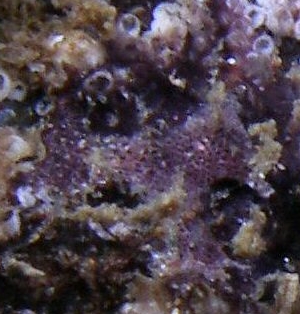
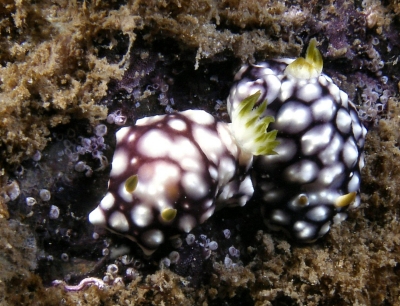
Dear Denis,
These photos may not show much detail but they show enough to confirm that this is Chelonaplysilla violacea, which appears to be the favoured food of this species.
I know we need a lot of rain after years of drought, but this is the part of the Australian rain-drought cycle which is not good for coastal ecosystems as the flood of freshwater kills off many shallow water plants and animal colonies. As you have observed, much of the plant and animal growth will die off, and the animal life dependent on it for food and/or shelter will die off as a consequence. Looking at the sponge colonies in your photos, they don't look that healthy either, so it possible that C. geometrica and other chromodorids will also disappear for a while, especially around river mouths.
Best wishes,
Bill Rudman
Chromodoris geometrica and sponge
September 4, 2007
From: Kenneth Yong
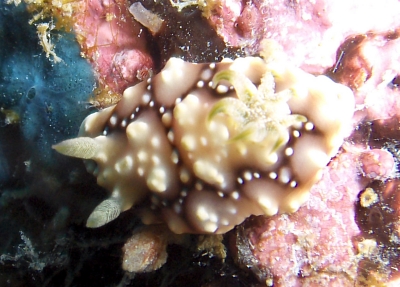
Dear Bill,
In response to your request for photos showing the aggregation of C. geometrica and their vicinity to a purplish-brown sponge, I'm sending a slightly fuzzy photo of a C. geometrica near a blue-gray sponge, taken near the one that was laying eggs. Hope this helps, and thanks a million once again for your help.
Locality: Lang Tengah Island, Nibong Karang divesite, 15 m, Terengganu, Malaysia, South China Sea, 09 July 2007, On vertical face of rocky boulder. Length: 6-7 cm. Photographer: Kenneth Yong
Cordially,
Kenneth
kyong67@tiscali.it
Yong, K., 2007 (Sep 4) Chromodoris geometrica and sponge. [Message in] Sea Slug Forum. Australian Museum, Sydney. Available from http://www.seaslugforum.net/find/20635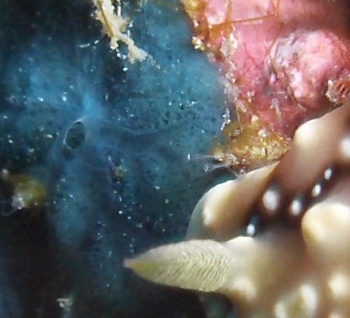
Dear Kenneth,
Blue sponges like this aren't so common, so it is interesting that the C. conchyliolata has been found with a sinilar blue sponge [#14108]. As you will have guessed from other messages the usual food of C. geometrica is the dark purplish Chelonaplysilla violacea, but is is possible that it feeds on another species as well. It's also possible that the nudibranch and the sponge together is just a coincidence, but since a similar sponge has been photographed with a closely related species, think we should keep a look out for it again.
Best wishes,
Bill Rudman
Chromodoris geometrica laying eggs
September 3, 2007
From: Kenneth Yong
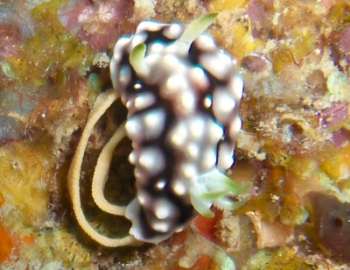
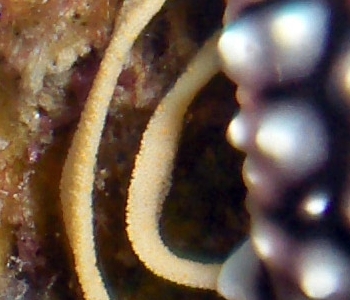
Dear Bill,
Here are 2 photos of Chromodoris geometrica. The 1st shows it laying eggs. Nearby, scattered on the almost vertical surface of a boulder were other C. geometrica (I counted a total of 16), with the largest group made up of 3 animals (photo 2).
Locality: Lang Tengah Island, Nibong Karang divesite, 15 m, Terengganu, Malaysia, South China Sea, 09 July 2007, on vertical face of boulder. Length: 6-7 cm. Photographer: Kenneth Yong.
Cordially,
Kenneth
kyong67@tiscali.it
Yong, K., 2007 (Sep 3) Chromodoris geometrica laying eggs. [Message in] Sea Slug Forum. Australian Museum, Sydney. Available from http://www.seaslugforum.net/find/20621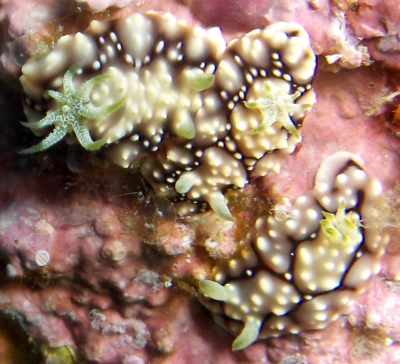
Dear Kenneth,
This species is one of those reported to have extra-capsular yolk so its nice to get another photo to confirm that. Can you check out your other photos of this species to see if you have any of it on a dark purplish brown sponge - or any sponge for that matter. When I see or hear of aggregations of a species like this, I always suspect their food sponge must be nearby
Best wishes,
Bill Rudman
Chromodoris geometrica from Tofo, Mozambique
August 28, 2007
From: Natasja Vandeperre
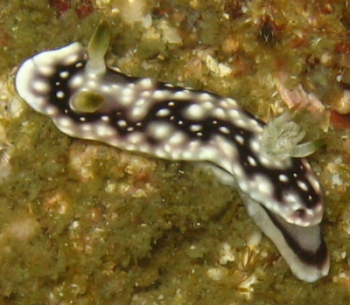
Hello Bill,
This tiny beauty is Chromodoris geometrica. I was surprised to see such a small nudi crawling at such a speed.
Locality: Tofo, Mozambique, Indian Ocean, 22 July 2007. Length: 10 mm. Photographer: Natasja Vandeperre.
Since I started questioning the biology of nudibranchs about one year ago, I got really fascinated by these amazing creatures. You're website is a very valuable source for me to learn about them. I'm very happy to do something in return. I know Tofo is mainly known for it's manta's and whalesharks, but there's also a enormous variety on smaller creatures including nudibranchs.
Best wishes,
Natasja
postmaster@naaktslakken.be
Natasja Vandeperre, 2007 (Aug 28) Chromodoris geometrica from Tofo, Mozambique. [Message in] Sea Slug Forum. Australian Museum, Sydney. Available from http://www.seaslugforum.net/find/20548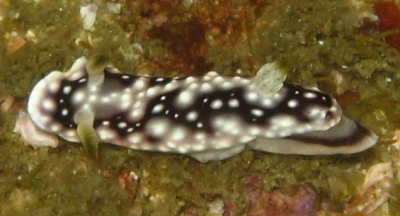
Dear Natasja,
Thanks for all your input, as I mentioned before we know so little about nudibranchs from Mozambique that all your records are valuable. It is good to get anoter record of typically coloured C. geometrica from the Indian Ocean because I had initially thought that this species was restricted to the western Pacific, and was replaced in the Indian Ocean by the similar looking Chromodoris conchyliolata.
Best wishes,
Bill Rudman
Chromodoris geometrica laying eggs
July 12, 2007
From: Kerem Turker
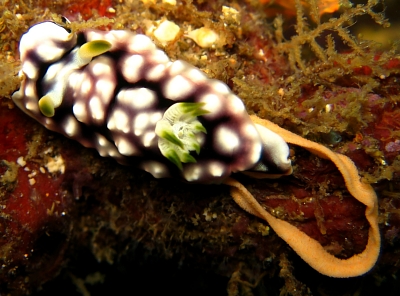
Dear Bill,
I know that you like to get photos of nudis doing things, hope this photo of Chromodoris geometrica is a good inclusion to your data.
Locality: The Passage Raja Ampat, 8 meters, Indonesia, SW Pacific Ocean, 24 March 2007, Sandy bottom, coral covered rocks along the passage. Length: 40 - 50 mm. Photographer: Kerem Turker.
Best Regards,
Kerem
kerem.turker@pmintl.com
Turker, K., 2007 (Jul 12) Chromodoris geometrica laying eggs. [Message in] Sea Slug Forum. Australian Museum, Sydney. Available from http://www.seaslugforum.net/find/20190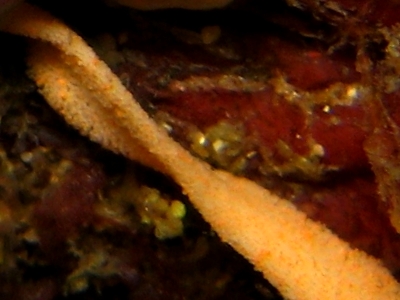
Dear Kerem,
Although we have photos of this species laying eggs it is always good to get another one because this species is characterised by having extra-capsular yolk [see Scott Johnson's mesage #5694]. It's function is unknown - I don't even know if it is 'yolk', but by having records of quite a few animals with this same type of egg ribbon certainly shows that it is not a strange one-off anomaly.
Best wishes,
Bill Rudman
Chromodoris geometrica from Cebu
April 3, 2007
From: Dr. Christine Meier
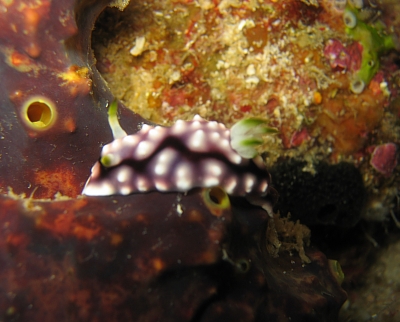
Dear Bill,
We found this nudibranchs during a wall dive at Cebu, Philippines. Looks like a mixture between a Phyllidiidae and a Chromodorididae, but I never have seen a similar before.
Can you kindly identify it?
Locality: Dive site: Pescador Island, about 20 m, Cebu, Moalboal, Phillipines, Pacific, 04 March 2007, carol reef, wall. Photographer: Tine Meier.
Thanks & best regards,
Tine and Schade
tinemeier@web.de
Meier, T.S., 2007 (Apr 3) Chromodoris geometrica from Cebu. [Message in] Sea Slug Forum. Australian Museum, Sydney. Available from http://www.seaslugforum.net/find/19783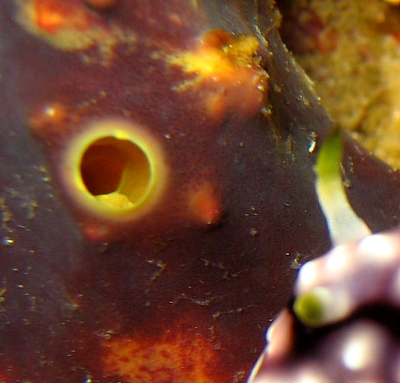
Dear Tine,
This is Chromodoris geometrica, and as you say, it is quite a good phyllidiid mimic. Have a look at the mimicry Fact Sheet for some more examples of phyllidiid mimics. The dark sponge your animal is on is quite intersting as I suspect it is its usual food sponge Chelonaplysilla violacea. Usually this sponge has a rougher appearance than in you photo due to the incorporation of sand grains into its outer skeleton. It also does not usually have the yellowish tinge either. It is also possible that the dark purple Chelonaplysilla is overgrowing a yellow sponge. We still have much to learn about sponge growth forms and colour variation as well. This is an interesting addition to our knowledge of the species
Best wishes,
Bill Rudman
Re: Chromodoris geometrica and egg mass
November 30, 2006
From: Asther Lau
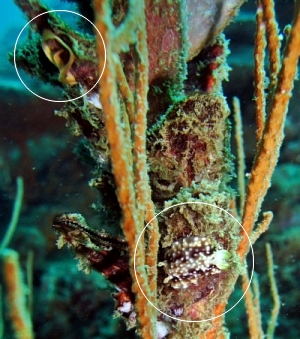
Concerning message #5694:
Dear Bill,
Attached is a photo taken of a Chromodoris geometrica & possibly its eggs mass. Hope this is helpful for the forum although the photo was not that clear.
Locality: Maya Corner, Phi Phi Island, Approx. 10 metres, Phuket, Thailand, Andaman Sea, 4th January 2006, Tropical coral reef. Length: About 4cm. Photographer: Asther M. Lau.
Regards,
Asther
asther@astherlau.com
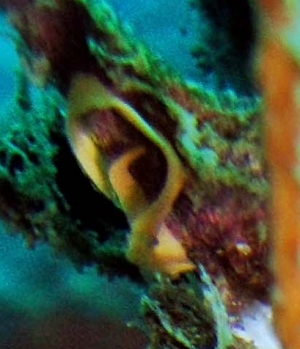
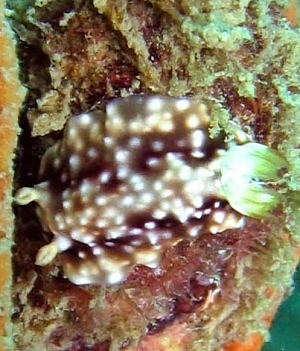
Dear Asther,
The eggs look quite like the orange egg masses of this species but as you suspect, it's not possible to be sure from the photo that the nudibranch laid the eggs..
Best wishes,
Bill Rudman
Chromodoris geometrica? from Fiji
August 22, 2006
From: Patty Dilworth
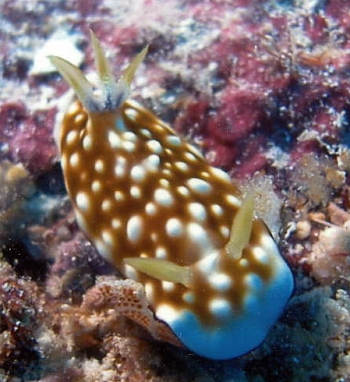
Hi Bill,
My daughter, Kara Miller, found this little guy when we were diving out of Matagi Island in Fiji, June 2006. I left my dive log at our home in Hawaii so don't have the depth and location info..Sorry..
Locality: Matagi Island, Fiji Islands, June 2006, reef dive. Length: 7mm. Photographer: Patty Dilworth.
It measured about 7 mm and looks a bit like Chromodoris geometrica, but I am having some trouble with the background color. It does have the purple color on the foot which is visible in another photo I took.
Thank you so much for your help.
Patty Dilworth
padilworth@aol.com
Patty Dilworth, 2006 (Aug 22) Chromodoris geometrica? from Fiji. [Message in] Sea Slug Forum. Australian Museum, Sydney. Available from http://www.seaslugforum.net/find/17510Dear Patty,
I have never seen one with quite this colour pattern before, but I am pretty sure it is C. geometrica. It seems to be missing the dark purple reticulate pattern on its mantle. However the greenish colour on both the gills and the rhinophores, and the signs of deep purple on the underside of the anterior mantle, are pretty good indicators that this is C. geometrica.
Best wishes,
Bill Rudman
Chromodoris geometrica in Wakatobi, Indonesia
August 20, 2006
From: Stephen Trainor
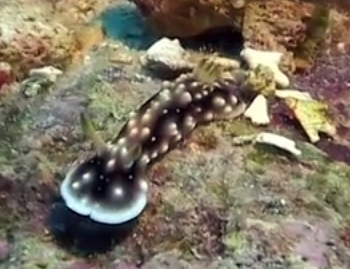
I'd be grateful if someone could confirm the species in the attached image as Chromodoris geometrica. I shot some video of this in Wakatobi, Sulawesi in May 2006 - the characteristic movement seems to match the description given here.
Locality: Wakatobi, 12m, Sulawesi, Indonesia, Banda sea, May 2006, Reef. Length: 50 mm ?. Photographer: Stephen Trainor.
Video is located here: http://stephentrainor.com/qt/indonesia_nudibranchs.mov
Thanks,
Stephen
stephen.trainor@gmail.com
Trainor, S. J., 2006 (Aug 20) Chromodoris geometrica in Wakatobi, Indonesia. [Message in] Sea Slug Forum. Australian Museum, Sydney. Available from http://www.seaslugforum.net/find/17541Dear Stephen,
Yes this is C. geometrica. Apart from the typical colour pattern, your video also shows its characteristic flapping of the anterior mantle. I am also pretty sure the pinkish purple patches visible in the photo - and more so in the video - are the remains of a colony of its food sponge Chelonaplysilla violacea.
Best wishes,
Bill Rudman
Chromodoris geometrica from Terengganu, Malaysia
August 4, 2006
From: Asther M. Lau
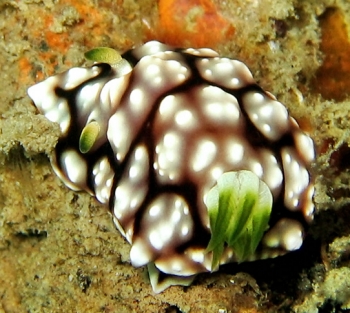
Hello Bill,
Found this Chromodoris geometrica during a wreck dive to a depth of 31 meters.
Locality: Tenggol Island, 31 meters, Terengganu, Malaysia, South China Sea, 24 July 2004, On a wooden wreck. Length: 3cm. Photographer: Asther M. Lau.
Regards,
Asther
asther@astherlau.com
Lau, A.M., 2006 (Aug 4) Chromodoris geometrica from Terengganu, Malaysia. [Message in] Sea Slug Forum. Australian Museum, Sydney. Available from http://www.seaslugforum.net/find/17314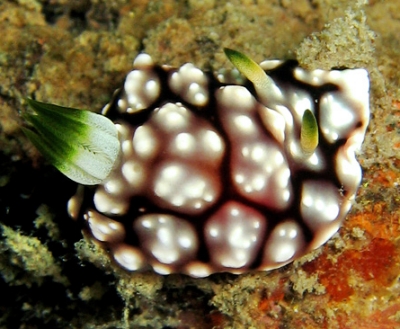
Thanks Asther,
Apart from the general colour pattern, the green-tipped gills and rhinophores are a very characteristic feature of this species.
Best wishes,
Bill Rudman
Chromodoris geometrica - feeding
April 8, 2006
From: Guido & Philippe Poppe

Dear Bill
Here are some photos of Chromodoris geometrica you may find interesting from our website on Philippines marine life at
http://www.poppe-images.com/.
Photos: Pescador Island, off Moalboal, Cebu, Philippines. 35 m. 2005. Copyright Guido & Philippe Poppe.
Best wishes,
Guido & Philippe Poppe
philippe@conchology.be
Poppe, G. & Poppe, P., 2006 (Apr 8) Chromodoris geometrica - feeding. [Message in] Sea Slug Forum. Australian Museum, Sydney. Available from http://www.seaslugforum.net/find/16256
Dear Guido & Philippe,
Thanks for this photo, which is a useful addition to the feeding records of this species, all of which refer to Chelonaplysilla violacea.
Best wishes,
Bill Rudman
Phyllidia mimic [2]
March 9, 2006
From: Kerry Hulme
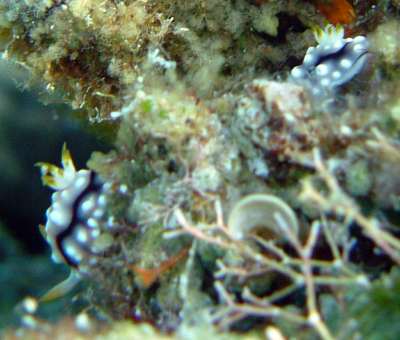
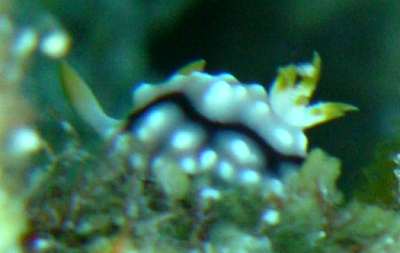
This Nudibranch was spotted whilst diving in the Philippines at a depth of 15m. I can't identify it, it looks really similar to a phyllidiidae but I thought this genus didn't have gills or visible gills?
Locality: Coron, 15metres, Philippines, Pacific, 19 April 2005. Length: 1 inch. Photographer: Kerry Hulme.
Please help, I'm very confused!
Kerry Hulme
HA211650@ntu.ac.uk
Hulme, K.E., 2006 (Mar 9) Phyllidia mimic [2]. [Message in] Sea Slug Forum. Australian Museum, Sydney. Available from http://www.seaslugforum.net/find/16048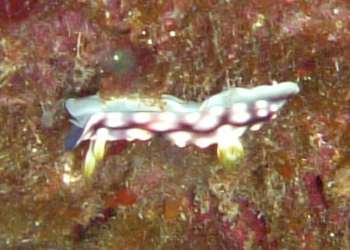
Dear Kerry,
When you see something that doesn't 'fit the book' you should be excited not confused. By great coincidence, your messages arrived about 30 minutes after Carl Scott's [#16040] about the very same species which he also described as a Phyllidia mimic.
My comments to his message obviously apply to your's as well. It is Chromodoris geometrica, and the yellow-green tipped gills and rhinophores are characteristic of that species.
Best wishes,
Bill Rudman
Phyllidia mimic [1]
March 9, 2006
From: Carl Scott
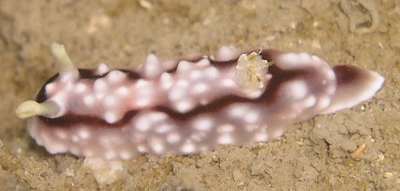
Attached is a photo of a nudi that I spotted on the rock island of Koh Doc Mai, near Phuket, Thailand. It clearly has external gills, yet closely resembles a Phyllidia species. I can't find it on your website, or any other reference.
Locality: Koh Doc Mai, 20 meters, Phuket, Thailand, Andaman, 20 January, 2006, rock wall. Length: 3 cm. Photographer: Carl Scott.
Please assist with identification.
Thanks.
Carl Scott.
cdscott@swbell.net
Scott, C.D., 2006 (Mar 9) Phyllidia mimic [1]. [Message in] Sea Slug Forum. Australian Museum, Sydney. Available from http://www.seaslugforum.net/find/16040Dear Carl,
Have a look at the Fact Sheet on mimicry to see the many nudibranchs, and odd flatworm, that are very similar in colour pattern to species of the Phyllidiidae. Your animal is the chromodorid Chromodoris geometrica. Apart from being very similar in colour, it is one of the few species of Chromodoris which don't have a smooth mantle - the whitish rounded tubercles being an extra 'trick' in mimicking a species of Phyllidiella.
Best wishes,
Bill Rudman
Chromodoris geometrica with one rhinophore
December 2, 2005
From: Asther Lau
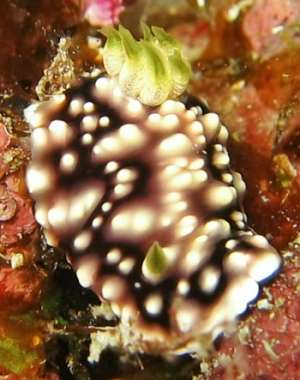
Dear Bill,
Here I have a Chromodoris geometrica with one missing rhinophore. Could be from old injury or mutated?
Locality: Sipadan Island, Sabah, Malaysia, Celebes Sea. Depth: 20 metres. Length: 1.5 cm. March 12, 2004. Wall of Coral Reef. Photographer: Asther Lau
Regards,
Asther M. Lau
asther@astherlau.com
Lau, A, 2005 (Dec 2) Chromodoris geometrica with one rhinophore. [Message in] Sea Slug Forum. Australian Museum, Sydney. Available from http://www.seaslugforum.net/find/15364Dear Asther,
I am pretty this is an injury rather than a developmental abnormality, but I could be wrong.
Best wishes,
Bill Rudman
Re: Chr. geometrica & Chr. conchyliata from S. Africa
November 12, 2005
From: W. van Zyl
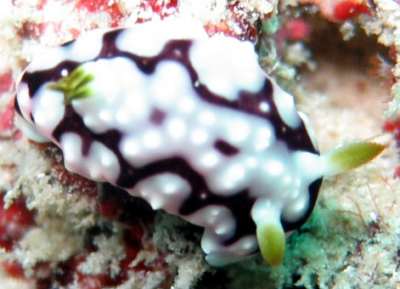
Hi Bill,
To follow on from an earlier message [#2570], I found another example of Chromodoris geometrica and Chromodoris conchyliata in the Westen Indian Ocean. The Chromodoris geometrica in the upper right photo was taken on the northern point of Unguja island, Zanzibar, while the other two animals were photographed at Pemba Island, just north of Zanzibar Is..
Locality: Pemba and Unguja Is. Zanzibar, Tanzania, Indian Ocean. Depth: 15 m. Length: 1 - 2 cm. 10 October 2005. Coral reef. Photographer: Wilhelm van Zyl
Regards
Wilhelm van Zyl
diving@cyberdale.co.za
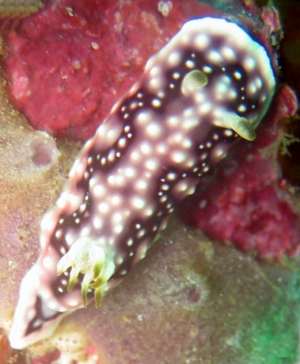
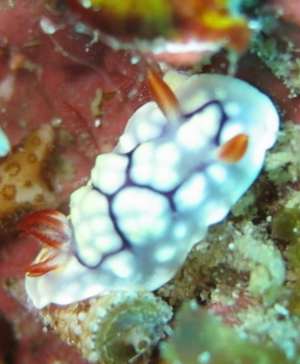
Dear Wilhelm,
Thanks for these photos. It ceratinly nice to get more photos of C. geometrica from the western Indian Ocean. The green on the gills seems to be a very consistent feature of this species.
Best wishes,
Bill Rudman
Chromodoris geometrica - Phyllidiid mimic
October 7, 2005
From: Paul Osmond
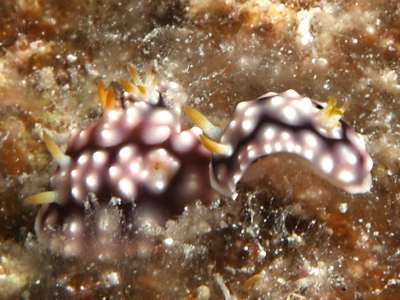
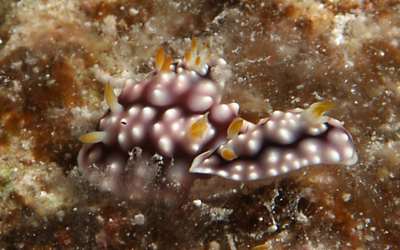
Bill,
I found this group of I believe phyllidiid nudibranchs on a night dive on Flinders Reef off the coast of Townsville in Queensland, Australia. I haven't been able to figure an exact species (or even if I am looking in the right direction) so any help is appreciated.
There was roughly 10 individuals in a small area, all about an inch in size. We were roughly in 15m of water.
Thanks,
Paul
www.deepseaimages.com
marriard@deepseaimages.com
Osmond, P., 2005 (Oct 7) Chromodoris geometrica - Phyllidiid mimic. [Message in] Sea Slug Forum. Australian Museum, Sydney. Available from http://www.seaslugforum.net/find/11597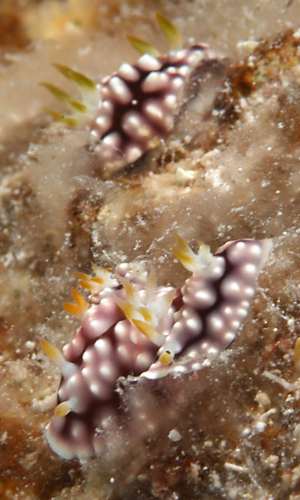
Dear Paul,
This is Chromodoris geometrica. No great shame in thinking it is a phyllidiid. It is one of the classic phyllidiid mimics - but the circlet of gills tends to sabotage its mimicry.
You would think that a cluster of animals together like this would mean it would be easy to find what its favourite sponge food was. These photos are cropped versions of 6 or 7 of yours which I searched diligently for signs of an identifiable sponge, but they show no more than the ones I am posting - which is nothing! All I can say is that they have eaten the sponge out, or else it is partially overgrown by other growths. I am not desperate to know what sponge it feeds on as I have records of it on the purple sponge Chelonaplysilla violacea, but it well illustrates how difficult it is to build up feeding information on these animals.
Best wishes
Bill Rudman
Chromodoris geometrica from Indonesia
June 9, 2005
From: Bob Whorton
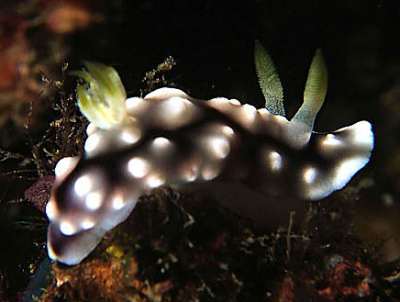
Here is a photo of a small nudibranch taken in Lembeh during the middle of May this year.
Locality: Lembeh Strait, Sulawesi, Indonesia. Depth: 24 M. May 2005. Coral Reef.Photographer: Dr Bob Whorton.
Cheers,
Bob
drbob.whorton@btinternet.com
Whorton, R., 2005 (Jun 9) Chromodoris geometrica from Indonesia. [Message in] Sea Slug Forum. Australian Museum, Sydney. Available from http://www.seaslugforum.net/find/13929Dear Bob,
This is Chromdoris geometrica.
Best wishes,
Bill Rudman
Chromodoris geometrica from Western Australia
June 21, 2004
From: Kristin
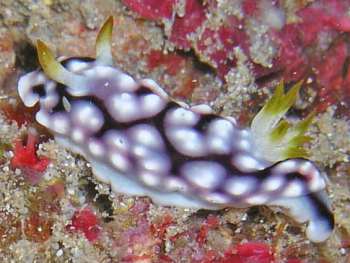
Just attaching a picture of Chromodoris geometrica taken yesterday (18 April, 2004) on Ningaloo Reef, off Exmouth, Western Australia - specifically on Blizzard Ridge.
There were two about 6 inches apart. Depth was about 13m. They were on the side of a small coral head protected by another small coral head directly in front. Photography was a challenge, so the images aren't great, but this is the first time I have seen them on the Ningaloo.
Kristin
kristin@exmouthdiving.com.au
Kristin, 2004 (Jun 21) Chromodoris geometrica from Western Australia. [Message in] Sea Slug Forum. Australian Museum, Sydney. Available from http://www.seaslugforum.net/find/12643Thanks Kristin,
It's an interesting record from Western Australia. As you will see from other messages on the Forum there are very few records of this species from the Indian Ocean, but the green tipped gills certainly distinguish it from the similarly coloured Indian Ocean species C. conchyliolata.
Best wishes,
Bill Rudman
Chromodoris geometrica laying eggs
September 2, 2003
From: Asther M. Lau
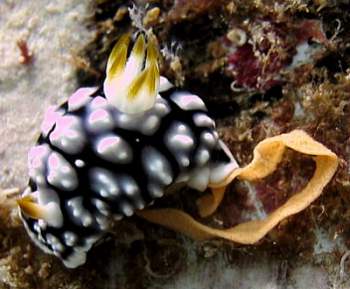
Hi Bill,
Took this photo during my dive at Soyak Wreck, Tioman Is. I do not know which species is it but I hope this will be useful for you on your collection of nudies laying eggs.
Site: Soyak Wreck, Tioman Is. Malaysia
Depth: 27 meter
Date: 9th August 2003
Size: About 1.5 cm in its current position
Asther M. Lau
diveworldwide@yahoo.com
Lau, A.M., 2003 (Sep 2) Chromodoris geometrica laying eggs. [Message in] Sea Slug Forum. Australian Museum, Sydney. Available from http://www.seaslugforum.net/find/10872Dear Asther,
Thanks for another vaulable addition. This is
Chromodoris geometrica. From messages in the Forum, there seems to be some variation in colour of the egg ribbon of this species throughout its range [see Scott Johnson's message] so any additional photos may be useful in sorting out this possible anomaly
Best wishes,
Bill Rudman
Chromodoris geometrica from Fiji
July 4, 2003
From: Paul Sim
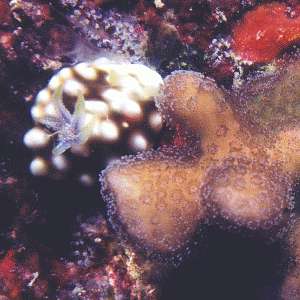
Hi Bill.
Could you please help me to identify this fellow? It's a terrible photo but maybe you will recognize it by the gills?
Salamanda Wreck, on outside of hull.
Mamanuca Group, Fiji. 85 feet
Nikonos-V 1:2 Fuji Reala 100
Thanks
Paul Sim
plsim@shaw.ca
Dear Paul,
The general colour pattern and the green-tipped gills are characteristic of Chromodoris geometrica.
Best wishes
Bill Rudman
Chromodoris geometrica from Malaysia
May 5, 2003
From: Harro Quitzau
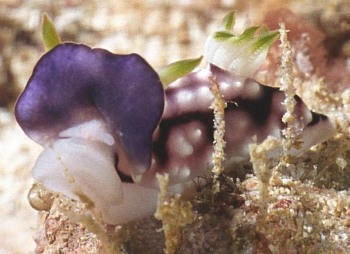
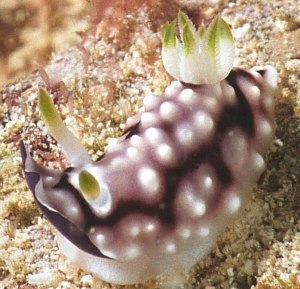
Hello Bill,
Here's are two nice pictures of Chromodoris geometrica.
Date: March 17, 2003.
Location: (Malaysia - Mabul), "Lobster Wall".
Regards,
Harro Quitzau
Harro@Quitzau.info
Quitzau, H., 2003 (May 5) Chromodoris geometrica from Malaysia. [Message in] Sea Slug Forum. Australian Museum, Sydney. Available from http://www.seaslugforum.net/find/9658Thanks Harro,
These photos show the green-tipped gills and rhinophores, and the purple underside of the anterior mantle very well.
Bill Rudman
Chromodoris geometrica feeding
March 28, 2003
From: Mary Jane Adams
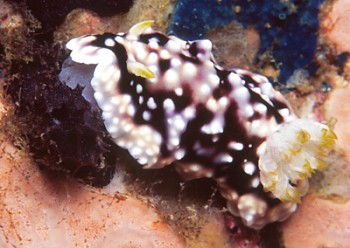
Hi Bill,
I photographed this Chromodoris geometrica feeding on a black sponge on a vertical wall at Black Rock, Mergui Archipelago, Myanmar on Feb. 15, 2003. Length: about 25mm, Depth: 5 meters. I wish I could be more helpful, but is impossible to photograph any detail on an all black subject. I think the only way to ID this sponge would be in a lab.
Best regards,
Mary Jane
divepng@yahoo.com
Adams, M.J., 2003 (Mar 28) Chromodoris geometrica feeding. [Message in] Sea Slug Forum. Australian Museum, Sydney. Available from http://www.seaslugforum.net/find/9466Thanks Mary Jane,
I assume its the same sponge as as Scott Johnson's series of photos from the Marshall Ids, and probably your recent photo of C. hintuanensis. From experience, these sponges are difficult to collect as they form such a thin layer over the rock or dead coral skeleton. Sponge experts need a whole thickness of the colony so often the only way is to collect the rock as well. Then there is the problem that often there may be two or more different species of sponge growing close together - or sometimes intertwined. After preserving the sponges in alcohol they lose their colour and so the obvious way of distinguishing the interwined colonies is gone. So you can't tell the expert 'I'm interested in the yellow bit' because its all now decolourised. Any way getting lots of photos establishes a pattern, so that when we get the chance to get a good specimen of the sponge, and get it identified, we can hopefully fill in a lot of gaps at once.
Best wishes,
Bill Rudman
Chromodoris geometrica from Bali
January 14, 2003
From: Danny Van Belle
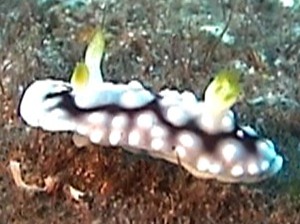
Hi Bill,
I think this is Chromodoris geometrica.
Filmed at Tulamben, Bali, Indoneisa - May 2000. Depth about 3 meters
Cheers,
Danny Van Belle
dannyvb@hotmail.com
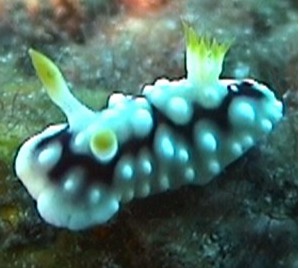
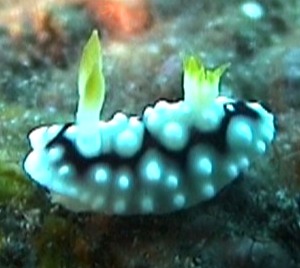
Dear Danny,
Yes this is Chromodoris geometrica. The yellowish green gills distimguish iyt from similarly coloured species.
Best wishes
Bill Rudman
Phyllidiella mimic from nothern NSW
November 23, 2002
From: Allan Saben
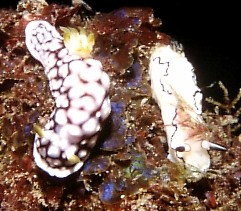
Dear Bill,
I took this photo at North Head, Sydney Harbour, NSW [Australia] in about 18 meters of water. I am not sure if the animal on the left is a Phyllidiella pustulosa or not.
Many thanks,
Allan
asaben@bigpond.net.au
Saben, A., 2002 (Nov 23) Phyllidiella mimic from nothern NSW. [Message in] Sea Slug Forum. Australian Museum, Sydney. Available from http://www.seaslugforum.net/find/8434Dear Allan,
The one on the right is Glossodoris atromarginata and the one on the left is Chromodoris geometrica. Have a look at the Mimicry page foir sme examples of nudibranchs and other animals which look like, or mimic, phyllidiids. If this was a phyllidiid it would not have the circle of yellowish gills.
Best wishes,
Bill Rudman
Chromodoris geometrica from Fly Point
October 18, 2002
From: Akos Lumnitzer
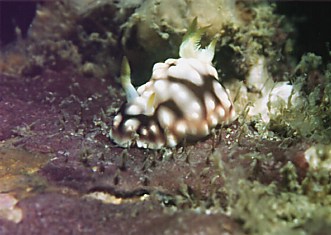
Hi Bill,
While diving Fly Point at Nelson Bay, my friend found this Chromodoris geometrica on its typical food sponge. The nudibranch was around 15mm long and it was in 6 meters of water on a rubbly bottom. March 2002.
Regards
Akos
Akos.Lumnitzer@exel.com
Lumnitzer, A., 2002 (Oct 18) Chromodoris geometrica from Fly Point. [Message in] Sea Slug Forum. Australian Museum, Sydney. Available from http://www.seaslugforum.net/find/6411Thanks Akos,
It's always nice to get a feeding observation
Bill Rudman
Chromodoris geometrica from nthn Sulawesi
July 4, 2002
From: Helmut Schirmböck
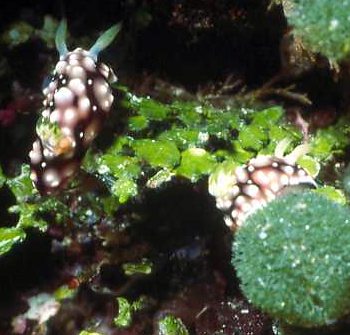
Dear Bill,
Here is a picture for your site, if you need, all taken Bunaken Is - Lembeh Strait region of Nth Sulawesi, Indonesia, but I don't know the diveplaces anymore. Sorry.
Regards,
Helmut.
schirmis@aon.at
Schirmböck H., 2002 (Jul 4) Chromodoris geometrica from nthn Sulawesi. [Message in] Sea Slug Forum. Australian Museum, Sydney. Available from http://www.seaslugforum.net/find/7423Thanks Helmut,
This is Chromodoris geometrica. They look quite like the white-spotted animals in Stuart Hutchison's message from Bali.
best wishes,
Bill Rudman
Chromodoris geometrica from Port Stephens
March 30, 2002
From: David Harasti
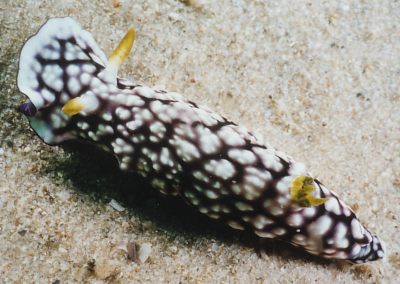

Dear Bill,
I thought I would send a couple of pics of Chromodoris geometrica. This animal was found at Fly Point, Port Stephens, New South Wales, Australia in March 2002. Water temp was about 21 degrees and I have found the same animal on 4 separate dives over two weeks in water depths from 5-10 metres.
The animal has been moving around the same region of Fly Point during the two weeks, I think the furthest he would have travelled between sightings had been about 30 metres.
Regards,
David
diving@webone.com.au
Harasti, D., 2002 (Mar 30) Chromodoris geometrica from Port Stephens. [Message in] Sea Slug Forum. Australian Museum, Sydney. Available from http://www.seaslugforum.net/find/6560Thanks David,
Bill Rudman
Chromodoris geometrica from Bali
February 23, 2002
From: Stuart Hutchison
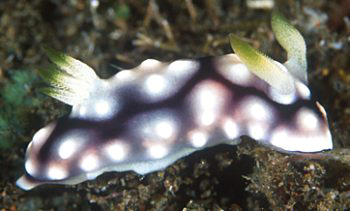
Bill,
Much like Chromodoris hintuanensis, these guys were found in the shallows on rocks and volcanic sands in Bali, Indonesia in Oct 2001. Lengths varied between 20 and 40mm.
Stuart
stuart@stuarthutchison.com.au
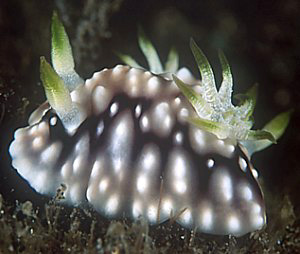
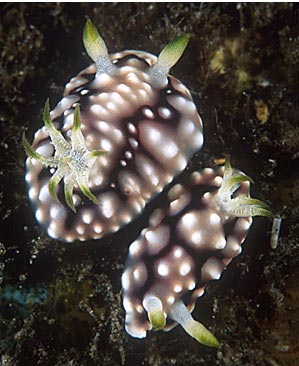
Thanks Stuart,
It's interesting to see the colour variation, some animals without white tubercles on the black markings, looking very like phyllidiids
Best wishes,
Bill Rudman
Re: Chromodoris geometrica and egg mass
November 22, 2001
From: Scott Johnson
Hi Bill,
Valda Fraser's Chromodoris geometrica egg mass is interesting. Here in the Marshalls, the egg ribbon of this species is always light orange or peach colored as in John Chuk's photo. The actual eggs are pure white, but the ribbon color comes from small bright orange extra-capsular yolk bodies, usually distributed as a cap adjacent to each ovum. These bodies are not unique to Chromodoris geometrica; many species of the genus Chromodoris whose eggs I have seen in the Marshalls and in Hawaii have these orange-capped eggs. Those Chromodoris species that do not possess extra-capsular yolk here all have egg masses deposited flat on the substrate like those of Chromodoris elisabethina, which are pictured on the Forum. I really thought I had a potentially significant taxonomic character here for a while, but the pattern breaks down over on the west coast of the Americas. Species of Chromodoris I found in the Sea of Cortez had upright egg coils (not the flat ones of C. elisabethina) that lacked any trace of orange extra-capsular yolk. Oh, well. Of course, the Chromodoris species I saw in the American continental areas were not the same ones as those I saw in the central and west-central Pacific. To have a single species such as C. geometrica show such different egg masses in cooler water at what is likely the edge of its range is interesting indeed. I'd be curious to see if other species whose egg masses typically possess extra-capsular yolk bodies show a similar pattern. Such species include C. tinctoria, C. decora, C. albopunctata, C. kuniei, C. rubrocornuta, and others.
Scott
johnson@kmr.ll.mit.edu
Johnson,, 2001 (Nov 22) Re: Chromodoris geometrica and egg mass. [Message in] Sea Slug Forum. Australian Museum, Sydney. Available from http://www.seaslugforum.net/find/5694Thanks Scott,
I look forward to a flood of egg mass photos
Bill Rudman
Chromodoris geometrica and egg mass
November 8, 2001
From: Valda Fraser
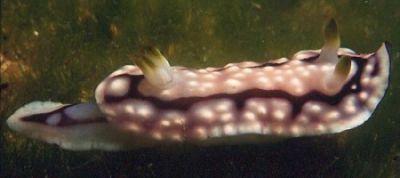

Dear Bill
Chromodoris geometrica laid this egg mass.
Locality: Pumula, south coast KwaZulu-Natal, South Africa, 18 m
Date: Oct 2001
Size: 25 mmm
Regards
Valda Fraser
valdafraser@mweb.co.za
Fraser, V., 2001 (Nov 8) Chromodoris geometrica and egg mass. [Message in] Sea Slug Forum. Australian Museum, Sydney. Available from http://www.seaslugforum.net/find/5593Dear Valda,
Thanks for these interesting photos. It's interesting to see C. geometrica so far from its previously known range. I don't know whether the colour difference between your eggs and those in John Chuk's photo is significant, but it suggests we should look at a few more egg masses. Perhaps they change colour during development, or perhaps the colour of their food is important. Or perhaps it is a sign of geographical variation.
best wishes,
Bill Rudman
Egg-laying Chromodoris geometrica from PNG
October 31, 2001
From: John Chuk


Dear Bill,
Here are two images that may be of some interest. They are of an egg-laying specimen of Chromodoris geometrica taken on 5/10/89, at a depth of 10m, on the 'Powerhouse Reef', Bougainville Island, Papua New Guinea. The specimen was 20mm in length.
Thanks for all your help.
Best wishes,
John.
jchuk@giant.net.au
Chuk, J., 2001 (Oct 31) Egg-laying Chromodoris geometrica from PNG. [Message in] Sea Slug Forum. Australian Museum, Sydney. Available from http://www.seaslugforum.net/find/5574Thanks John,
Another very useful observation.
Best wishes,
Bill Rudman
Chromodoris geometrica from Papua New Guinea
October 24, 2001
From: Marli Wakeling
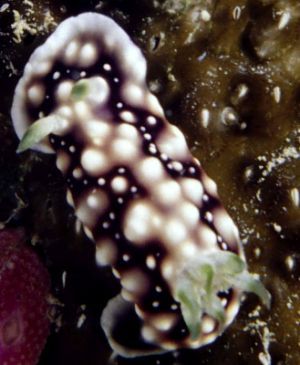
Hi Bill,
Another nudibranch from Kavieng Harbour: Chromodoris geometrica.
Dive Site: The Old Slipway, Kavieng Harbour, Papua New Guinea, July 28, 2001
Depth: 5 metres
Length: 40mm
Photograph: Marli Wakeling
Marli
scubamarli@excite.com
Wakeling, M., 2001 (Oct 24) Chromodoris geometrica from Papua New Guinea. [Message in] Sea Slug Forum. Australian Museum, Sydney. Available from http://www.seaslugforum.net/find/5530Thanks Marli,
Bill Rudman
Chromodoris geometrica from Indonesia
June 12, 2001
From: Stuart Hutchison
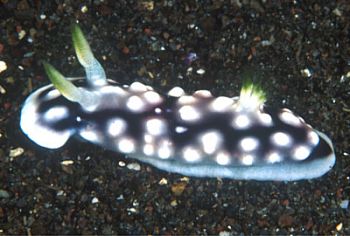
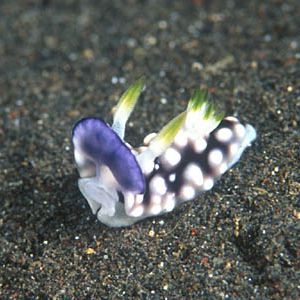
Bill,
Here's a nice Chromodoris geometrica from Tulumben, Indonesia. Found at 4m on 12 May 2001, the animal was about 30mm long.
Regards,
Stuart
hutchco@tpg.com.au
Hutchison, S., 2001 (Jun 12) Chromodoris geometrica from Indonesia. [Message in] Sea Slug Forum. Australian Museum, Sydney. Available from http://www.seaslugforum.net/find/4488Thanks Stuart,
If I was running a competition, I think your lower photo is the best I've ever seen of C. geometrica flapping the front end of its mantle and showing its characteristic purple underside.
Best wishes,
Bill Rudman
Chromodoris geometrica ? from the Maldives
June 1, 2001
From: Jim Anderson
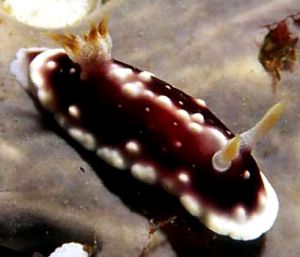
Dear Dr. Rudman,
I am trying to ID my Maldive photos and have difficulty with this one (and some others). Can you help confirm that this is C. geometrica or whatever? It was photographed in Ari Atoll near Vakurufahli resort at a site known as Noo Giri in the Maldives in January 1996. The animal was approx 25mm long and was found during a daytime dive at 20 metres in a coral cave.
Regards,
Jim A
jander4454@aol.com
Anderson, J., 2001 (Jun 1) Chromodoris geometrica ? from the Maldives. [Message in] Sea Slug Forum. Australian Museum, Sydney. Available from http://www.seaslugforum.net/find/4440Dear Jim,
It looks like this dark colour form has a fairly widespread distribution with photos in the Forum from the Philippines and Papua New Guinea. Nathalie Yonow (1994) has also reported this colour form previously from the Maldives. One characteristic of C. geometrica which seems to distinguish it from similarly coloured species such as C. conchyliata and C. hintuanensis is the yellow-green rhinophores and greenish tipped gills.
• Yonow, N. (1994) Opisthobranchs from the Maldive Islands, including descriptions of seven new species (Mollusca: Gastropoda). Revue fr. Aquariol., 20(4): 97-130.
Best wishes,
Bill Rudman
Chromodoris geometrica from Thailand
January 29, 2001
From: Erwin Koehler
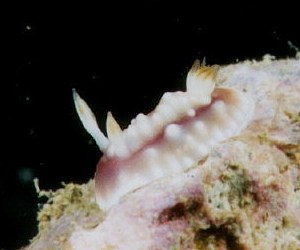
Dear Bill,
here is the next one from Thailand, Phuket, divesite "Shark Point II", depth 15m, size 12mm, Dec. 19, 2000. It looks like
Chromodoris geometrica, but might be something else
Erwin
Medslugs.Koehler@t-online.de
Koehler, E., 2001 (Jan 29) Chromodoris geometrica from Thailand. [Message in] Sea Slug Forum. Australian Museum, Sydney. Available from http://www.seaslugforum.net/find/3656Dear Erwin,
Certainly looks like C. geometrica to me
Bill Rudman
Chromodoris geometrica & C. conchyliata from S. Africa
June 26, 2000
From: V.Fraser
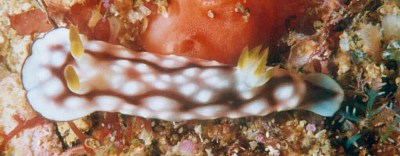
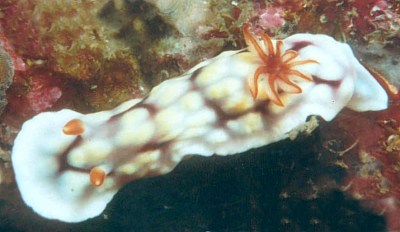
Dear Bill
I am sending you two photos taken in the same area. I think they are Chromodoris geometrica. The one with the greenish rhinophores and gills (UPPER PHOTO) is very common. The other form (LOWER PHOTO) is an uncommon variation. I would appreciate your comments.
Locality: Scottburgh - 25m - south coast KwaZulu-Natal, SOUTH AFRICA
Date: June 2000
Size: 35mm
Regards
Valda Fraser
Dear Valda,
This is another interesting find. As I discussed in an earlier message from Bernard Picton, the typical green-gilled C. geometrica has been considered essentially a Western Pacific species, although Nathalie Yonow has reported it from the Maldives. We thought that in the Indian Ocean C. geometrica was replaced by a similarly coloured animal, Chromodoris conchyliata, which differs in having orange-red edging to the gills and the upper half of the rhinophore clubs orange-red.
Your photos clearly show that both species co-exist in the western Indian Ocean. Your UPPER photo is of Chromodoris geometrica and the LOWER one Chromodoris conchyliata.
It would ne nice to know if the two species differ in the sponges they eat or the shape and/or colour of their egg ribbon, and perhaps difference in egg size. So if you could keep that in the back of your mind with all the other things I have asked you to look out for .....
Best wishes,
Bill Rudman.
Chromodoris geometrica on sea cucumber
June 20, 2000
From: Mary Jane Adams
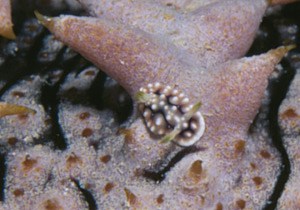
Dear Bill,
I found this 8mm Chromodoris geometrica on top of a sea cucumber (Thelenota ananas)on a coral rubble reef. Is this a known association or do you think it is just an incidental finding?
Middle Reef, New Hanover, Papua New Guinea, Aug. 10, 1997. Depth 7 meters.
Thanks,
Mary Jane
mjadams@earthlink.net
Adams, M.J., 2000 (Jun 20) Chromodoris geometrica on sea cucumber. [Message in] Sea Slug Forum. Australian Museum, Sydney. Available from http://www.seaslugforum.net/find/2597Dear Mary Jane,
I suspect this is one little lost Chromodoris. Being a sponge feeder I can't see much of a future for it on a sea cucumber.
Best wishes,
Bill Rudman.
Some more Chromodoris geometrica
January 29, 2000
From: Stuart Hutchison
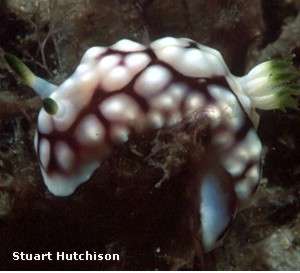
Dear Bill,
Here are some more examples of Chromodoris geometrica:
UPPER RIGHT: Nelson Bay, Port Stephens (New South Wales) and the others are from Milne Bay, Papua New Guinea). The one at LOWER RIGHT was a juvenile about an inch (2cm) long.
Regards,
Stuart Hutchison
hutchco@tpg.com.au
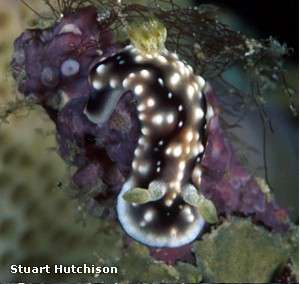
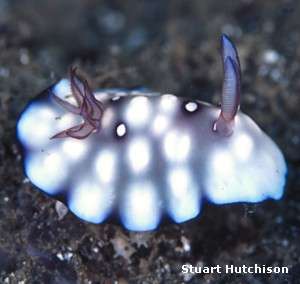
Thanks Stuart,
The bottom right animal has been recently named as a distinct species Chromodoris hintuanensis. I must say I used to think it was a colour form of C. geometrica. Have a look at the Chromodoris hintuanensis page for its characteristics.
Best wishes,
Bill Rudman.
Chromodoris geometrica from Japan
January 26, 2000
From: Yasuhiro Shirai
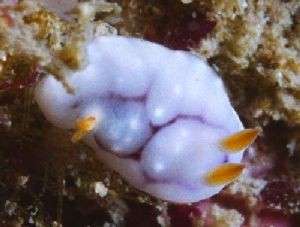
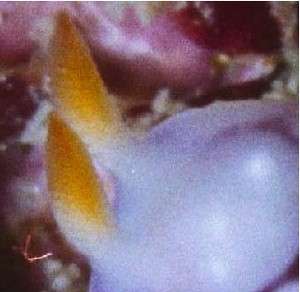
Dear Bill,
Thank you for your quick reply every time.
This time,I attached 2 files. At first,I thought that this is Chromodoris geometrica but previously I have only seen C. geometrica, in warm seas with coral reefs. But this one was found in cool waters. I don't think C. geometrica has been found around here before now.
What do you think about this one? Could it be a juvenile C. geometrica?
Data:
Location: Shima Pref. Mie Japan (Kii Peninsula east side)
Length: 4mm
Water temperature: 13C
Date Jan. 2000
Depth: 3m
moving on rock wall.
Best regards,
Yasuhiro Shirai
http://www.e-net.or.jp/user/yasuhiro/
yasuhiro@e-net.or.jp
Shirai, Y., 2000 (Jan 26) Chromodoris geometrica from Japan. [Message in] Sea Slug Forum. Australian Museum, Sydney. Available from http://www.seaslugforum.net/find/1785Dear Yasuhiro,
I am sure your animal is a juvenile C. geometrica. Although they are usually found in warmer water, C. geometrica is also sometimes found in the cooler waters of southern New South Wales, here in Australia. Veliger larvae from tropical waters are sometimes carried into colder regions in warm currents or small eddies of warm water. If the larvae find the right food they can settle and metamorphose into little crawling slugs in quite cool waters. However it is always a risky business and if they or their food sponge can't survive in colder waters then the nudibranch will not grow to adulthood. Perhaps that it why larger specimens are not usually found at Kii Peninsula.
Best wishes,
Bill Rudman.
Chromodoris geometrica from Marshall Ids
August 21, 1999
From: Scott Johnson
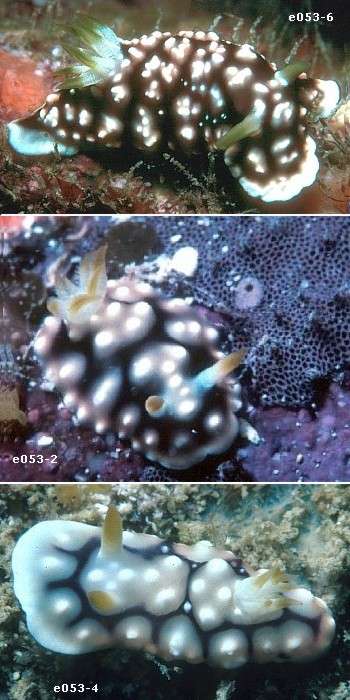
Hi Bill,
Attached are several photos of variation in Chromodoris geometrica in the Marshall Islands. The species is not uncommon at Kwajalein and Enewetak Atolls. Smaller specimens often, but not always, have yellow-orange rhinophores and gills, while in the larger adults (photo E053-6), the rhinophores and gills are nearly always green. Background dorsal color also varies from gray to black, and larger specimens often have scattered white spots in the black areas.
E053-1 shows a very small individual from Enewetak on the typical prey sponge, tentatively identified as Aplysilla violacea. Although a bit difficult to see in this picture, the specimen of C. geometrica in E053-1 is also interesting because its gills protrude from underneath the posterior mantle margin -- obviously a deformity.
Scott
johnson@kmr.ll.mit.edu
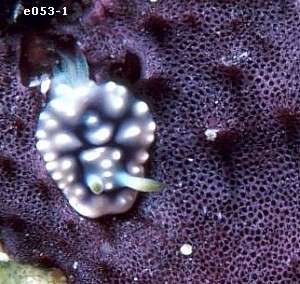
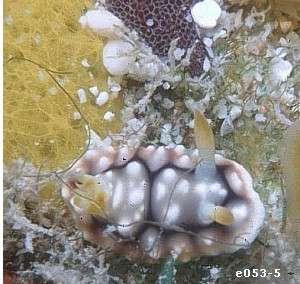
Dear Scott,
Thanks for the sponge photos and the colour variation. Chromodoris ambiguus, Chromodoris thompsoni and the spotted form of Chromodoris fidelis all feed on similar looking purple sponges.
The animal with the gills beneath the mantle is interesting. Charles Eliot described a specimen of Hypselodoris infucata as a new species and genus, Chromodoridella mirabilis Eliot 1905, because it had the gills attached below the mantle edge.
Best wishes,
Bill Rudman.
Reference: Eliot, C.N.E. (1905). On some nudibranchs from the Pacific, including a new genus, Chromodridella. Proceedings of the Malacological Society of London, 6: 229-238
Rudman, W.B., 1999 (Aug 21). Comment on Chromodoris geometrica from Marshall Ids by Scott Johnson. [Message in] Sea Slug Forum. Australian Museum, Sydney. Available from http://www.seaslugforum.net/find/1212Chromodoris geometrica waving anterior mantle
January 15, 1999
From: Erwin Koehler


Bill,
Here are 2 photos of one Chromodoris geometrica (Risbec, 1928), Siquijor Is.,
Philippines, Nov. 1998 showing how it waves with the mantle at it's head,
Erwin
E.Koehler@deutschepost.de
Koehler, E., 1999 (Jan 15) Chromodoris geometrica waving anterior mantle. [Message in] Sea Slug Forum. Australian Museum, Sydney. Available from http://www.seaslugforum.net/find/474Thanks Erwin,
Your 20+ images of interesting nudibranchs from the Philippines arrived yesterday. I will post them over the next few days. By coincidence I have just posted a photo of the same colour form of C. geometrica with a flatworm mimic from Michael Miller.
Bill
Chromodoris geometrica & C. conchyliata
December 20, 1998
From: Bernard Picton
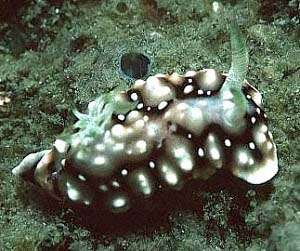
Hi Bill,
Talking about Phyllidia mimics brings the subject to Chromodoris geometrica. I note that the 'Chromodoris geometrica' in Terry Gosliner's South African book has red gills and rhinophores. I've now seen quite a lot of the typical Indonesian ones, they have green rhinophores and gills and are probably
distinct.
Bernard
bernard.picton.um@nics.gov.uk
Picton, B., 1998 (Dec 20) Chromodoris geometrica & C. conchyliata. [Message in] Sea Slug Forum. Australian Museum, Sydney. Available from http://www.seaslugforum.net/find/411Dear Bernard,
As you will see here, Chromodoris geometrica in the Western Pacific has greenish gills and rhinophores, although quite pale in some specimens. In the western Indian Ocean there is a similarly coloured species in which the gills and rhinophores are lined with red or reddish-orange and the pustules are often quite yellowish. It is possible that the western Indian Ocean "form" reaches the Indonesian Archipelago, but as yet I only know, as you do, of the greenish-gilled form.
I reported and illustrated the Indian Ocean colour form from Kenya in 1973 - my first publication on chromodorids! - as Chromodoris cf. geometrica and Nathalie Yonow (1984) described it from Sri Lanka as a new species, which she named Chromodoris conchyliata
Best wishes,
Bill Rudman.
References:
Rudman, W.B. (1973a) Chromodorid opisthobranch Mollusca from the Indo-West Pacific. Zoological Journal of the Linnean Society 52(3): 175-199.
Yonow, N. (1984). Doridacean nudibranchs from Sri Lanka, with descriptions of four new species. The Veliger, 26(4): 214-228.
Chromodoris geometrica feeding
December 4, 1998
From: Akos Lumnitzer
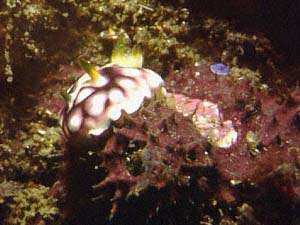
Dear Bill,
I photographed this slug at La Perouse, at the entrance of Botany Bay, Sydney. I first saw it in late October 1998, 7 meters, on this sponge. It stayed on the sponge for two consecutive dives.
Akos Lumnitzer.
AKOS72@hotmail.com
Lumnitzer, A., 1998 (Dec 4) Chromodoris geometrica feeding. [Message in] Sea Slug Forum. Australian Museum, Sydney. Available from http://www.seaslugforum.net/find/355Dear Akos,
This is another tropical species making a rare visit as far south as Sydney. it is interesting to have a photo of it on a food sponge. The sponge is almost certainly a dendroceratid, which are characterised by the loss or great reduction in skeletal spicules. The small bluish slug in the background, on the same sponge looks like Chromodoris thompsoni which is known to feed on Chelonaplysilla violacea, another purplish dendroceratid sponge with a much more encrusting growth form... Bill Rudman.
